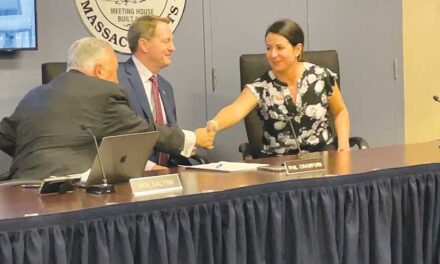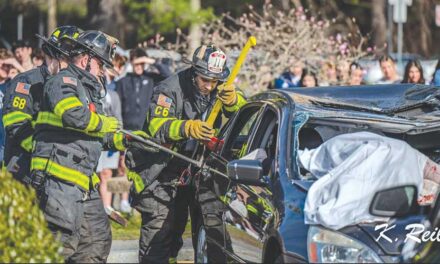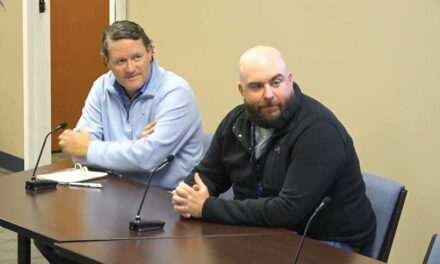By DAN TOMASELLO
LYNNFIELD — The Class of 2014’s SAT scores increased slightly but High School Principal Bob Cleary told the School Committee last week there is still room for improvement.
Students are graded on three different areas on the SAT — critical reading, writing and math for a combined score of 2400. The Class of 2014’s average mean score for all three areas was 1604. The Class of 2013’s average mean score was 1532.
The data revealed the average critical reading score increased by seven points, from 513 to 520. The average writing score was 534, representing an 18-point increase from the Class of 2013’s average score of 516.
“We are encouraged with some of the progress we have made in our English language arts scores but we are always looking to get better,” said Cleary.
While the average critical reading and writing scores increased, the Class of 2014’s math scores fell by three points, from 553 to 550.
The data Cleary presented to the school board was SAT scores taken by last years’ graduates in the spring of 2013.
Cleary also presented average SAT mean score data from area communities Hamilton-Wenham, Masconomet, North Andover, North Reading, Rockport, Swampscott and Wakefield. Lynnfield’s average critical reading scores were lower than all seven communities. In writing, the high school’s average scores were higher than North Reading, Swampscott, Rockport and Wakefield, but were lower than Hamilton-Wenham, Masco and North Andover.
The high school’s math scores were higher than North Reading, Swampscott and Rockport, but were lower than Hamilton-Wenham, Masco, North Andover and Wakefield.
The high school’s SAT scores have been a growing concern for the School Committee the past couple of years, particularly after the Class of 2013’s scores dropped significantly from the Class of 2012. In order to address the SAT’s downward trend, Cleary and high school officials developed an SAT improvement plan to boost scores. The plan includes utilizing more timed writing assignments, revamping the vocabulary program and using SAT-inspired problem of the day questions.
“We are trying to prepare students without teaching to the test,” said Cleary.
Cleary said the high school previously emphasized untimed writing assignments to help students prepare for the MCAS exam but he said high school officials have been incorporating more timed writing assignments in classes.
“Over the last year or so, we have started to implement more and more timed writing assignments in the classroom and hopefully that is why we have seen an increase in our writing scores,” said Cleary.
School Committee member Jamie Hayman asked Cleary how many high school students are using Community Schools’ SAT prep course to prepare for the exam.
Cleary said Community Schools’ SAT prep class participation rate has “dwindled” in recent years because a number of students have opted for private SAT tutors. He noted a number of students use private SAT tutors because they participate in extra curricular activities, which conflict with the SAT prep class.
While the high school does not have data on the percentage of students using private testing companies, guidance department head Michael Moresco said, “There is a fair number of our students who are using private tutors.”
Moresco also said the high school does not advocate that students use private testing companies. “We do not think its fair for the kids who cannot afford it,” he said.
Cleary said the high school will survey students about whether or not they use private SAT tutors or enroll in the Community Schools SAT class.
School Committee Vice Chairwoman Susie Cleary asked Principal Cleary if he has reached out to communities such as Hamilton-Wenham and North Reading to see how they are preparing students for the SAT and whether or not they encourage using private SAT tutors.
Principal Cleary said high school officials are “constantly” reaching out to surrounding high schools to ask them about their preparation methods. He said Hamilton-Wenham officials have told him a number of their students are using private tutors.
“They are asking us what we do and we are asking them what they are doing,” Principal Cleary added. “It’s very similar.”
Moresco said English department head Maryellen Iannibelli reached out to English department heads at Hamilton-Wenham and North Reading to “see if there was a curriculum based response they were using to help students on the test.” According to Moresco, the department heads told Iannibelli the key to those high schools’ success was “simple good teaching practices.”
“It wasn’t anything out of the ordinary and one school said they do nothing on purpose,” said Moresco.
Hayman asked Moresco if the high school’s SAT scores are having an impact on students’ college choices.
Moresco said the high school’s goal is to educate students and parents to “make them as educated of a consumer as possible so they can make good choices.” He also said seniors conduct research before deciding which schools to apply to, including evaluating SAT or ACT criteria.
“I would be foolish not to acknowledge at a certain level of college, you need to have a certain set of scores and if you don’t have them, you are not going to get in,” Moresco added.
School Committee Chairman Chris Barrett inquired if there is any way to decipher whether or not the SAT scores headed upward in the fall after the Class of 2014 took the exam the previous spring.
Cleary said students may take the SAT two or three times and said the best score is used during the college application process.
“It’s called super scoring,” Moresco added. “College Board filters out every score except the highest math, high critical reading and highest writing scores.”
While Hayman said it will take time for high school officials to see if the SAT improvement plan is working, he asked Cleary if he is “confident that we have the right plan in place to increase these scores?”
Cleary said he is confident in the plan. He said data analysis is ongoing and high school officials will continue to evaluate and revise the plan. He also noted different classes have different strengths and weaknesses.
“Part of the problem with the SAT is I don’t know what kids are doing wrong,” said Cleary. “We can take a look at how a 10th grader did on the PSAT but I don’t know what their strengths are and what they might have lost when they take the SAT a year later. It’s not always easy and its not always cut-and-dry.”
PSAT debate
The high school is encouraging more sophomores to take the PSAT to prepare students for the SAT. The PSAT is administered on two separate days in October, taking place on a Wednesday and Saturday.
In previous years, Moresco said 75 percent of juniors took the PSAT while 25 percent of sophomores took the exam. He said there is a good chance to increase the junior participation rate to 90 percent and the sophomore participation rate to 50 percent next year because the revamped SAT is going to be released in the spring of 2016.
“I am expecting a tsunami because people will want their child to take a practice run,” said Moresco.
Cleary said students get the PSAT results back after the exam is completed and scored by the College Board. Moresco said the PSAT results can serve as “an amazing source of data” for the high school to evaluate.
Barrett said he would like 100 percent of sophomores to take the PSAT. He suggested this take place on a future professional development day when the exam is administered in October. He said 100 percent of the sophomores at Everett High School opted to take the PSAT after EHS invited sophomores to take the exam.
“I think it will help us more if we push it to 100 percent,” said Barrett. “If it is bringing such good data back and can help an individual student improve their SATs, it will increase their chance to get into a better college.”
Cleary said the high school will take the proposal under advisement but he did express concerns about over testing and the material covered in the PSAT.
“We have always been wary about forcing more standardized testing on our sophomores who are already fairly over-tested,” said Cleary. “We need to be careful of the fact that some of the stuff tested on the PSAT sophomores haven’t learned yet. Some of the data isn’t always going to be consistent but it’s going to be valuable.”
Moresco said it would cost $4,000 to test every member of the sophomore and junior class next year.




